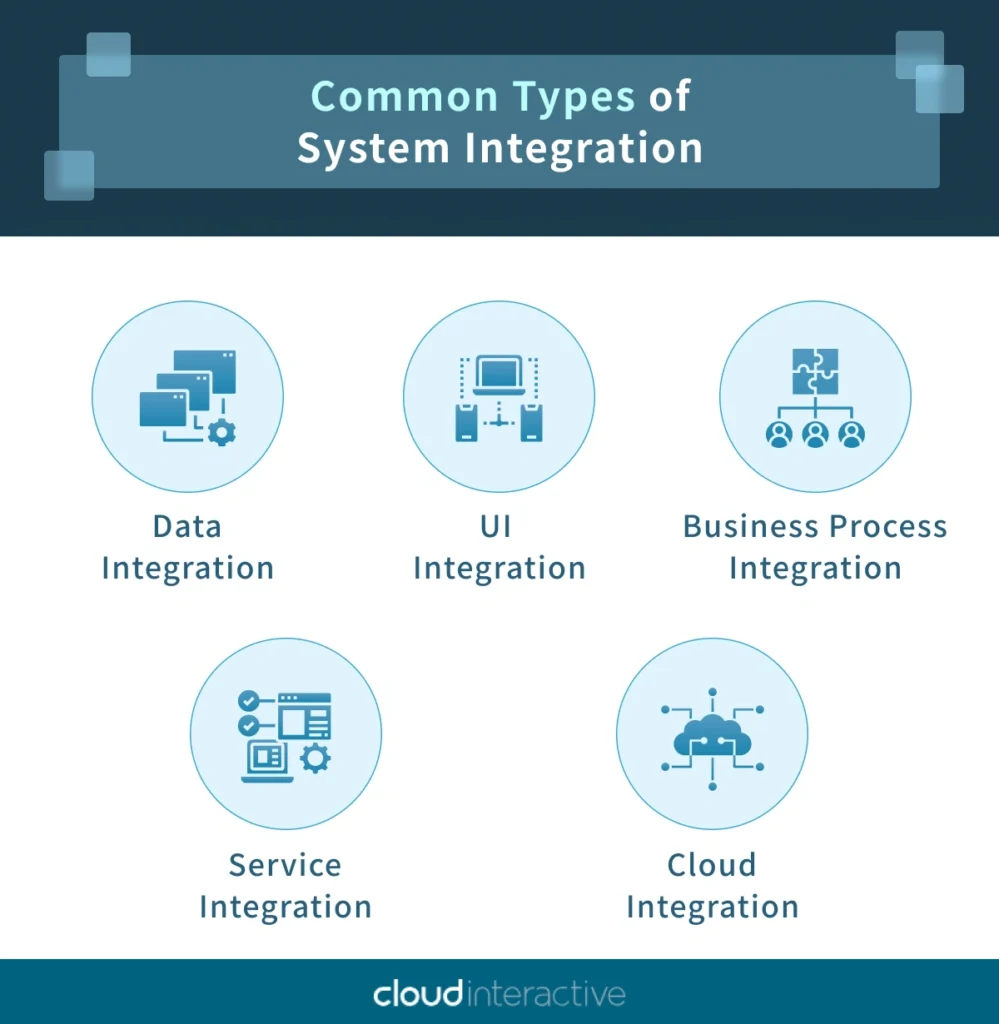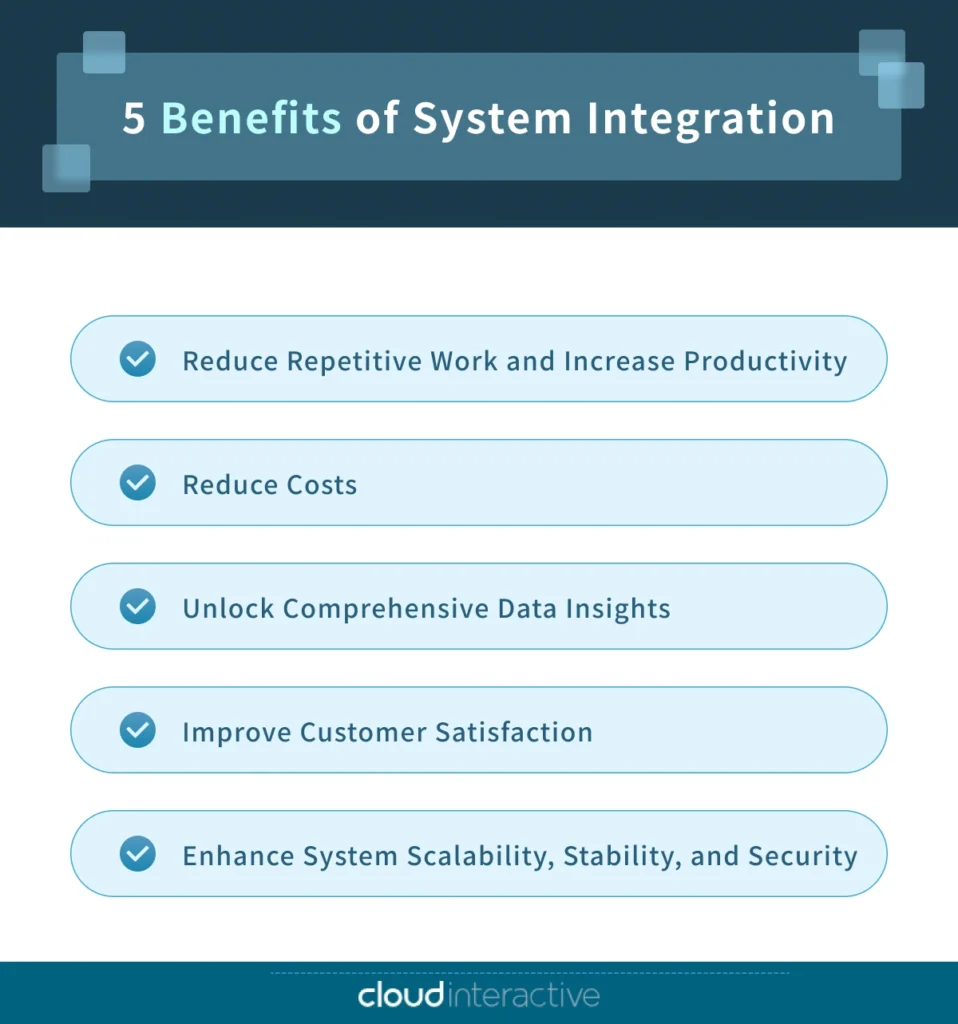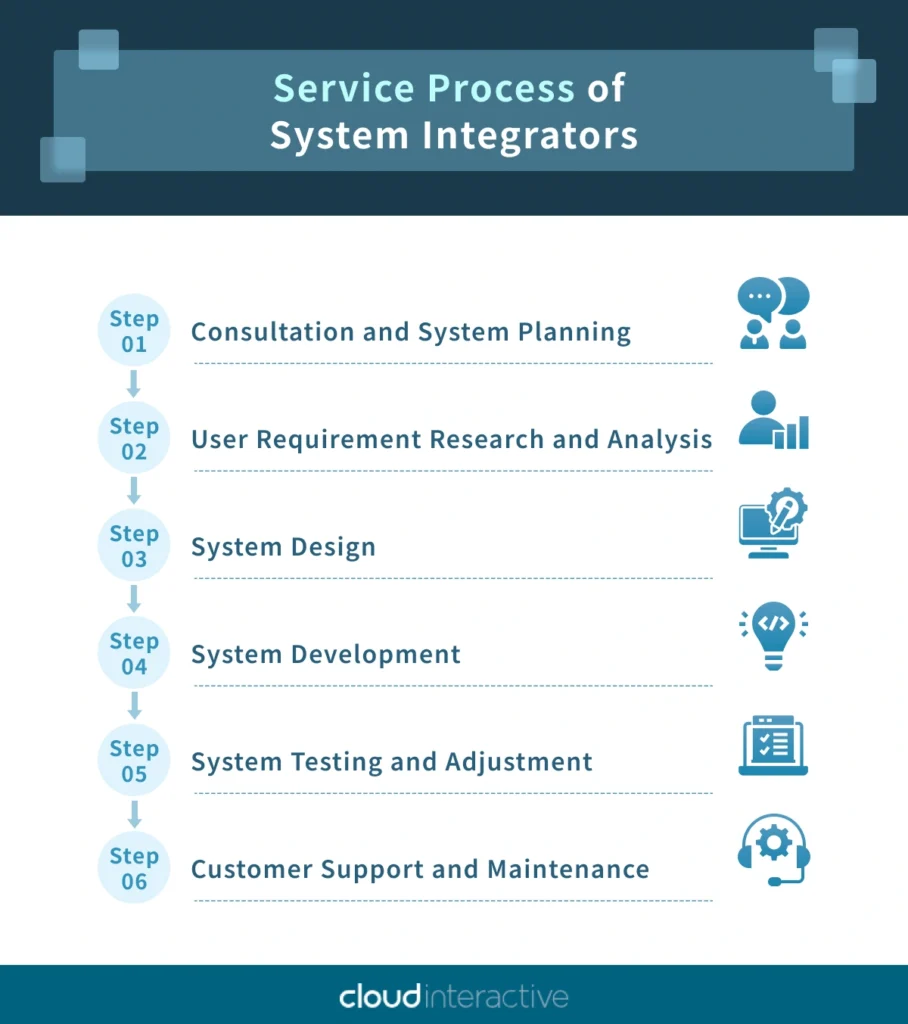
From Silos to Synergy: The Comprehensive Landscape of System Integrations
The conclusion presents tangible success stories from our customers, highlighting how system integration, with its cost-saving potential and customer-centric focus, is a transformative force that guides businesses toward success.
What is System Integration?

Common Types of System Integration
Data Integration
Data integration consolidates data from various sources, allowing users to access all information and data seamlessly. For example, in a company, the customer service department may have a customer service system, and the sales department may have a sales and inventory management system.
The data and software from these two systems can be consolidated through data integration, enabling the company to simultaneously review sales data and observe whether the customer service team receives any customer feedback after the sale. The data insight is beneficial for companies in adjusting sales strategies based on subsequent data analysis.
UI Integration
UI integration is the process of unifying the user interface across platforms and devices, reducing user learning curves and operation times while enhancing the intuitiveness of interface interactions. When integrating UI, it is crucial to ensure that the functions and designs of different interfaces align with users’ logic. This way, users can enjoy a consistent and positive experience when operating across various platforms or devices, ultimately elevating brand image and service quality.
Business Process Integration
As businesses expand, their processes can become more complex and extensive, necessitating improved integration and oversight. Business Process Integration (BPI), also known as process integration, is a methodology that connects people, applications, and data within businesses, simplifying and streamlining workflows across departments. It ensures that both personnel and software work together seamlessly to achieve the organization’s primary objectives.
Process integration removes redundancies, enhances communication, and improves productivity by linking and aligning individual tasks, steps, or functions across departments or systems.
Service Integration
The service integration process involves coordinating and consolidating various services, typically from different sources or providers, into a cohesive and well-organized system. This process may include combining software applications, hardware, cloud-based services, or other technological components to establish a unified and integrated environment that meets an organization’s specific needs and goals.
Cloud Integration
Why is System Integration Important?
As businesses expand and adopt various systems to execute their operations, they often encounter challenges of sharing data between these systems and the substantial workload required to maintain them separately.
Hence, system integration is a crucial element that enhances consumer service quality, improves employee efficiency, and reduces overall costs. Below are five key advantages of implementing system integration:

Reduce Repetitive Work and Increase Productivity
System integration ensures data flows seamlessly between various departments and systems. The integration eliminates manual data entry and repetitive tasks, allowing employees to focus more time on strategic and value-added activities. As a result, businesses can reduce the effort and time spent on mundane tasks.
Reduce Costs
By promoting seamless compatibility and efficient data exchange, system integration enables businesses to minimize expenses linked to developing and maintaining various systems, eliminating unnecessary investments. Organizations can strategically allocate resources through a cohesive integration approach, ensuring a streamlined and efficient operational environment.
Unlock Comprehensive Data Insights
Through system integration, consolidating information and data from diverse systems enables businesses to conduct more comprehensive and accurate data analysis. This data is a crucial foundation for informed decision-making and continuous enhancements to products and services.
Improve Customer Satisfaction
System integration standardizes internal workflows, creating a cohesive Standard Operating Procedure (SOP) that ensures consistency across all processes. Standardization guarantees consistent quality and response methods in customer service, thereby eliminating information discrepancies. The result is an improvement in customer satisfaction and loyalty.
Enhance System Scalability, Stability, and Security
Deploying systems in the cloud enables businesses to continue to add features, enhancing their service delivery. For example, features such as automated intelligent customer service are frequently used by e-commerce sellers, transaction notifications in WhatsApp/Messenger with banking systems, and online reservations.
When Do You Need An Integrated System?
With the advancement of technology and digitization, many companies are now utilizing electronic systems to manage internal data and information. Typical systems include Enterprise Resource Planning (ERP), Point of Sales (POS), Customer Relationship Management (CRM), and more.
When a company adopts multiple systems, it not only incurs expenses for system implementation but also faces substantial costs for system maintenance and updates. Additionally, there may be challenges with data interoperability between different systems. Consider system integration if your company is experiencing the following conditions:
Maintaining Outdated Systems
When a company relies on outdated systems that are not regularly updated or maintained, it exposes itself to potential system vulnerabilities, which can pose significant risks to data security. To address this issue, the company should consider replacing its obsolete systems. This replacement should involve integrating seamlessly with other systems to establish a cohesive and uniformly secure infrastructure.
Managing Multiple Existing Systems
If a company uses a mix of different systems, it should explore Enterprise Application Integration (EAI). This process involves combining multiple systems into a unified whole, achieved by connecting interfaces or using each software’s Application Programming Interfaces (APIs).
Insufficient Functionality of Existing Systems
As a business expands or enters a new era, the existing system functionalities might fall short of meeting the evolving business needs. Instead of solely replacing the system, employing system integration can upgrade the capabilities of the old system by incorporating new functionalities.
Organizational Adjustments and Mergers
When a company undergoes organizational changes or mergers, it may need to adjust its operational processes. System integration can help by combining existing systems or adding new features to ensure they work well with the company’s current plans. This approach can make the transition smoother and improve the overall efficiency of the integrated systems.
What Is a System Integrator?
In such instances, seeking assistance from a seasoned and professional system integration provider can offer comprehensive support and lead to substantial cost savings.
System integrators are experts in linking different subsystems or components to create a cohesive and functional system. They specialize in combining hardware, software, networking, and other elements to ensure seamless communication and collaboration, ultimately achieving the desired efficiency and functionality of the integrated system. They are crucial in designing, implementing, and managing complex solutions to meet specific business or technological requirements.
As a leading software development partner, Cloud Interaction can provide clients with complete system integration services. Organizations can optimize their operations, improve productivity, and achieve their business objectives by leveraging their expertise.
Contact Us
Would you be interested in enhancing your workplace efficiency through System Integration? Click the button below to contact us. Our consultants will be in touch with you soon.
What Does a System Integrator Do?
The service scope of system integration providers begins with understanding client requirements and encompasses system training, operation, and maintenance after system development is complete. The typical service process provided by system integration providers includes the following:

Consultation and System Planning
System integration providers begin by understanding the purpose and requirements of a company for system integration. They conduct a comprehensive analysis and evaluation of the company’s target audience, current challenges, organizational structure, and workflow.
User Requirement Research and Analysis
Once the solution is confirmed, the provider collects user experiences and analyzes user behavior to ensure the integrated system aligns with real user needs.
System Design
After consultation and user research, the provider begins system planning and design. They determine the integration method and provide a system integration plan while understanding the existing systems.
System Development
System Testing and Adjustment
Upon completing software development, the system enters the testing and adjustment stage. System integrators will contact Internal testing, collect user data and feedback, and adjust the system for optimal quality.
Customer Support and Maintenance
After the official launch of the integrated system, the provider assists the company in education and training. The company can continue to entrust the maintenance and updates of the system to the development company, ensuring system stability and security.
Success Stories: Real-World Applications of System Integration
1. Software and Hardware System Integration | Video Gaming Hardware Equipment Company
In this case, a company that produces computer peripherals and gaming equipment faced several challenges. Their application for device control could not interface with the newly created hardware, resulting in issues such as undetectable products, frequent crashes, and delays between the software and hardware.
The primary focus was on enhancing compatibility between software and hardware. The new user interface reflected the gaming style that aligns with the company’s image. The service also provided personalized scenario settings and RGB configurations, significantly enhancing the product’s competitiveness and delivering a superior consumer experience.
2. Enterprise Application Integration (EAI) | Leading F&B Group in Taiwan
This case involves a chain of restaurants with over 20 brands. Initially, each brand independently built its membership database, preventing the group from consolidating member statuses and consumer behavior.
To overcome this, we helped the customer integrate 20 brand membership databases into one unified system. We developed a comprehensive membership management system for the entire enterprise and created a dedicated B2C membership app.
This app allows members to access promotional information for all brands within the group. The company can now offer tailored marketing solutions based on member activity records, enhancing service quality and customer loyalty.
3. Enterprise Application Integration (EAI) | Leading Plastic Group
A traditional industrial group has initiated a project to modernize its operations by transitioning from manual, paper-based processes to an electronic system. The main objective of this transformation is to integrate systems with upstream and downstream vendors seamlessly. This integrated ERP system streamlines quoting, procurement, inventory management, and shipping processes, ultimately enhancing operational efficiency.
The new integrated system consolidates sales data on a single page, allowing easy access to various data types for sales analysis and management. The unified backend will enable quick queries of customer orders and logistics status.
Would you be interested in learning more about the benefits of System Integrations?
Click the button below to learn more about our case studies.
Leading System Integrator | Cloud Interactive
System integration has become crucial for businesses seeking to improve work efficiency and customer service.
With our substantial expertise in system integration, we are well-equipped to support industries such as finance, retail, logistics, transportation, manufacturing, and beyond in their digital transformation endeavors. We excel in custom system integration, offering specialized solutions to address the diverse needs and challenges that clients encounter. Recognizing that system integration must be finely tuned to each client’s unique requirements and cannot merely replicate past experiences, entrusting this task to an experienced system integration company becomes paramount.
Advantages of Cloud Interactive
- We are a team of skilled design and development professionals with over ten years of experience in large-scale software development projects across various industries.
- Our core philosophy is “human-centric design,” which emphasizes the interactive experience of user operations.
- We have a deep understanding of business problems and needs and insight into market and industry dynamics, allowing us to create tailored solutions for businesses.
- We maintain open communication and strong collaborative relationships internally and externally, offering real-time system update suggestions in a competitive environment.
- We adapt our development methods according to customer preferences, project attributes, and progress, providing an agile approach that allows us to adjust product development routes as the project progresses. Moreover, we employ a waterfall development method focusing on detailed product planning and development processes.
- Furthermore, we understand the cost considerations associated with system integration. We offer comprehensive services in system development, post-sales education training, and maintenance updates, ensuring you don’t have to compromise on quality or budget.
Conclusion: Embracing the Power of System Integration
Businesses seeking to thrive in today’s digital landscape must integrate their systems. System integration is not just a technical process; it’s a strategic imperative. By bringing together different systems, organizations can make their operations more efficient, improve customer experiences, and drive growth. Cloud Interactive can help businesses navigate the complexities of system integration, unlocking new possibilities and leading them to success in an increasingly interconnected world.
By Cloud Interactive
Meet the masterminds behind the curtain at Cloud Interactive. We're not just software developers - we're also a content crew fuelled by caffeine and a thirst for knowledge. We translate tech jargon into plain English, dissect industry trends, and craft helpful tips that are informative and engaging. So, buckle up and join us on a journey through the ever-evolving and exciting world of technology!
You may also like

Finding the Right Fit: How to Choose a Software Development Partner
It’s too costly to miss this guide! Discover how to choose the ideal software development partner. Learn the key criteria, evaluation strategies, and common pitfalls.

Navigating AI in Finance: A Guide for Enterprise Implementation Success
Want to succeed with AI in banking? Discover practical insights, proven use cases, and a step-by-step roadmap to AI transformation.

Construction Digitalization: A Complete Guide to Construction Management Systems
Learn what construction management software is, what it does, and how it supports every role on your team – from project owner to subcontractor.